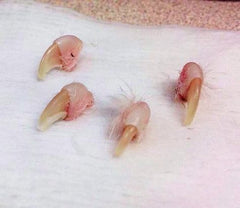|
ACT NOW: New Jersey Bill to Ban Declawing |
The Truth About Declawing
Despite the overwhelming information now available and legislation in place in many parts of the US and industrialized countries the world over banning the procedure, some cat owners today are still making the decision to declaw their beloved feline friends. They may choose this path because of small children, cat aggression, or a variety of other reasons that may seem logical but aren't — especially in full consideration of the procedure and its consequences.
Declawing a cat is a devastating practice that involves a non-reversible surgery — an amputation of parts of kitty's toes. That's right — this isn't just making the decision to get their kitty’s nails trimmed — this is about actually removing a portion of their living body. This is the reality:

As painful as that image is to see, it is far less painful than what a declawed cat experiences.
This surgery involves excruciating pain and weeks of what we humans call “phantom limb” due to the nerve endings in their tiny toes taking weeks to heal. During the recovery process, vets have witnessed cats bouncing off the walls of their crate due to the pain and yowling for weeks afterwards due to the drastic change to their anatomy. It's equivalent to amputating the last bone in your finger at the knuckle.

If the pain this declawing surgery puts cats through isn’t enough of a reason to not do it, here are a three more reasons to understand:
1. The pain doesn't stop at the surgery - declawing leads to joint issues or other long-term problems later on in life
Domestic cats walk on their toes, something that veterinarians refer to as “digitigrade.” If you ever look at a cat walking, you’ll see that he doesn’t walk on flat feet, but rather is poised on his tip toes. This is often why cats can sneak up on us so easily without making a sound because they’re tip-toeing around the house. It also is what makes outdoor cats such good hunters because they can stalk their prey quietly until the right moment comes to pounce.
When cats are declawed, an entire portion of the toe is removed. This causes the cat to have an altered walk because they don’t have the ability to walk on their toes anymore since that portion of the paw is gone. Long term, this leads to arthritis in a cat’s hips or elbows, which is incredibly painful and requires expensive medication to help ease the pain. It also can significantly decrease a cat’s lifespan, which is never what any pet owner wants for their beloved feline friend.
2. Declawing takes away a cat’s best method of defense
As all pet owners know, cat claws are how they defend themselves against dangerous threats—both in the wild and in a domestic setting. Cats in the wild use their claws to climb trees in order to escape from a predator or fight off an enemy by swiping at them. Since our feline friends stem from this long line of wild cat ancestors, they also use their claws to defend themselves, even in a domestic environment.
If your cat wanders outdoors, he probably uses his claws to defend himself against feral cats that stalk the streets, or takes a swipe at a dog barking at him, in order to stay safe. If your cat is an indoor cat, he could potentially use his claws to defend himself against an intruder who enters your home. A declawed cat wouldn’t stand a chance against the alley cats, intruders, or large dogs and even though he still has his teeth, it would be risking getting too close to the enemy in order to attack. The length of legs and paws gives a cat an advantage over their enemy, which is why it’s important to not remove this method of protection from our feline friends.
3. Declawing can lead to biting problems in cats
As mentioned above, when declawing a cat, owners are taking away his best defense mechanism. Most cats who feel threatened will do a “swipe” towards their enemy as a warning to stay away, but when they’re declawed, they don’t have the ability to warn their enemy. This leads to them using their next line of defense: teeth. A cat who is declawed will attack with a solid bite that can cause some serious damage. This may not be an issue outdoors, but owners may find that when their cat gets aggravated they’ll give them a hard bite, which is often more painful than a kitty scratch.
These are just a few of the top reasons why pet owners shouldn’t declaw their cat. It’s inhumane and takes away a cat’s natural ability to hunt, play, and defend himself.
If you’re even considering declawing your cat, be sure to educate yourself on the topic - we promise you'll not only reconsider, but will spread the word to other cat owners wondering whether they should undertake this grizzly procedure. A good place to start for more information is The Paw Project, where you can not only get more details and see visual animations explaining the procedure, but also learn other methods of keeping your cat happy and healthy.
In addition, here's a documentary they made that sheds more light on the topic:
Cat Amazing is making the commitment to help end this awful practice in any way we can. For starters, every Cat Amazing manufactured after the summer of 2018 will have a message printed on it to educate cat owners. From there, we will maintain an ongoing dialog with The Paw Project to see how else we can help them spread the word. And we're counting on your help too - share the message, and you may save a cat from a lifetime of pain - and their owner from a lifetime of regret.
